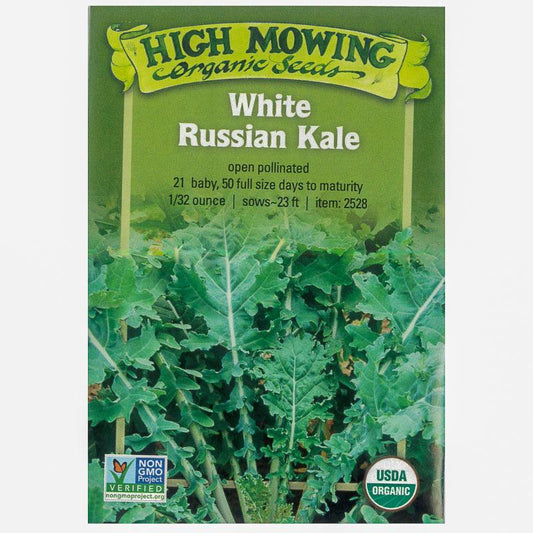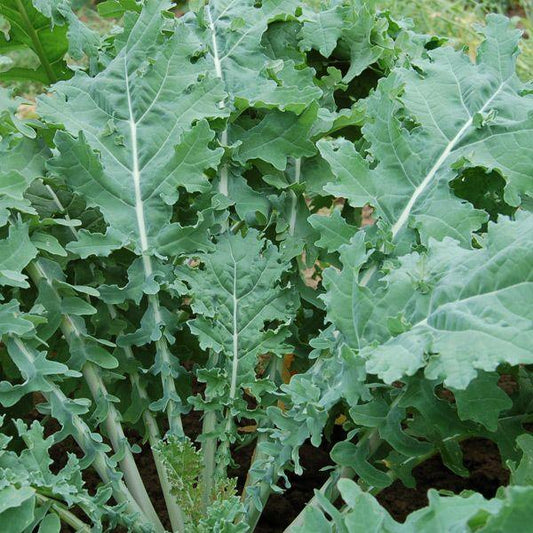Introduction
Kale, a type of non-heading cabbage or broccoli, is a member of the brassica family. In our, How to Grow Kale, Tricia shows us how to easy it is to grow kale in the garden. Kale comes in three basic varieties Scotch, Siberian and Bicolor. Scotch kales have grey-green leaves that are tightly curled and crumpled. Varieties include Lacinato and Scotch Blue Curled. Siberian kale has leaves which are blue-green and has smooth leaves with frilled edges. Examples include Siberian, White or Red Russian. All of these varieties are easy to grow, tasty and packed full of nutrition. 
Which Kale to Choose
So now you are sold on growing kale, which variety should you choose? Here is a short list of kale varieties and some qualities that may help you decide which one to choose:
- Red Russian – gourmet variety with red-purple veins, used in salads, cut and come again. Very mild, good in salads (see photo).
- Siberian – white stems with ruffled edges, hardy and fast growing. Mild flavor.
- Lacinato – also called Toscano kale or Dinosaur kale, thick crinkled leaves, grows to 48". Good for kale chips, very nice flavor (see photo below).
- White Russian – sister of Red Russian kale, moderately dissected leaves with white and green mid-veins. Mild taste.
- Ripbor – similar to Winterbor, more compact growth.
- Curly Roja – can be used as an ornamental or in an edible landscape.
- Scotch Blue Curled – one of the best frost resistant kales, finely curled leaves. Good in salads or for kale chips.
- Italian Tuscan Baby Leaf – fast growing, best tasting when picked small. Cut and come again.
- Portuguese Tronchuda Beira – more heat tolerant variety, paddle-shaped blue-green leaves, to 18", milder, sweeter flavor than other cole crops.
- Triple-Curled Dutch Darkibor – grows to 18", frilly leaves, mild and tender, good for kale chips or salads.

Health Benefits of Eating Kale
Kale is a superfood because it is packed full of nutrients. Just one cup of chopped kale contains 684% of the daily requirement of vitamin K, 206% of vitamin A and 134% of vitamin C! Kale also is packed full of antioxidants such as cartotenoids (lutein and zeaxanthin – help promote eye health, protect against cataracts and age-related macular degeneration) and flavonoids (more than 45) which have anti-cancer properties.
Just one cup contains 3 grams of dietary fiber and only has 36 calories! There are only a few drawbacks to eating a diet with kale. Because kale is high in vitamin K, which can interfere with blood thinning medications, you should consult a MD before eating a diet high in kale.
Check out our kale recipes on our resource page.
🥬 Resource Area: Kale Varieties, Nutrition & Growing Guide
Kale is more than a garden green—it's a resilient, versatile superfood that's easy to grow and packed with nutrients. Whether you're deciding which variety to plant or looking for health inspiration, this comprehensive resource guide will walk you through growing, cooking, and understanding kale, from seed to table.
- 📘 Why Is Lacinato Kale Called Dinosaur Kale?
Explore how Lacinato kale earned its Jurassic nickname and why its thick, textured leaves make it perfect for cooler gardens and gourmet dishes. - 🌱 Growing Dinosaur Kale in Northern California
Learn how to grow cold-hardy Lacinato kale in challenging microclimates like the Sierra Nevada foothills, including tips for January seed starting. - 🎥 How to Grow Kale (Video)
Follow along with a step-by-step video tutorial showing how simple it is to grow kale at home—from soil prep to harvest. - 🍽️ Kale Chips Recipe
Turn any kale variety into a crispy, addictive snack with this easy, healthy oven-baked recipe. - 🥗 Kale & Black Bean Salad Recipe
Combine tender kale with protein-packed beans and zesty flavors for a fast, nutritious meal or side dish. - 🛒 Shop Organic Kale Seeds
Choose from heirloom, curly, or Siberian kale seeds—all certified organic and ideal for home or market gardens.
💪 Health Benefits of Kale
Kale is a nutritional powerhouse rich in antioxidants, fiber, and vitamins A, C, and K.
-
🥬 Try Kale for Vitamin K and Cancer Protection – Tufts University
-
🥬 New Year’s Resolution: Eat More Kale – Iowa State Extension
Packed with lutein, zeaxanthin, and over 45 flavonoids, kale supports eye health, reduces inflammation, and may help prevent cancer. Just be mindful if you’re on blood-thinning medication—its high vitamin K content may affect dosage.




